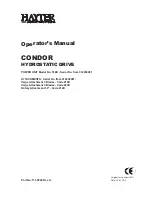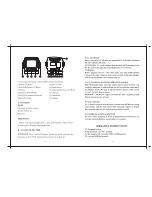
AUX I/O (Auxiliary Input/Output)
Provides for most of the rear panel BNC
connections through a single, 25-pin, D type
connector. Supports master-slave operation
with another synthesizer or allows for a single-
cable interface with the Model 56100A Scalar
Network Analyzer and other Anritsu
instruments. (see figure below)
SERIAL I/O (Serial Input/Output)
Provides access to RS-232 terminal ports to
support service and calibration functions and
master-slave operations.
IEEE-488 GPIB
Provides input/output connections for the
General Purpose Interface Bus (GPIB).
mmW BIAS
Provides the bias for the external waveguide
multipliers for coverage up to 110 GHz.
RF, LO, IF
Provides access to an internal IF up-
conversion mixer, Option 7.
PULSE TRIG IN
Accepts an external TTL compatible signal
to pulse modulate the RF output signal or to
trigger or to gate the optional internal pulse
generator. Available with Option 13,
Pulse Modulation.
PULSE SYNC OUT
Provides a TTL compatible signal,
synchronized to the internal pulse modulation
output, Option 24.
EXT ALC IN
Provides for leveling the RF output signal
externally with either a detector or power
meter. Signal requirements are shown in the
RF Output specifications.
RF OUTPUT
Provides for RF output from 50
Ω
source
impedance. K Connector, female. Option 9
moves the RF Output connector to the rear
panel.
10 MHz REF IN
Accepts an external 10 MHz ±100 Hz, 0 to
+20 dBm time-base signal. Automatically
disconnects the internal high-stability time-
base option, if installed. 50
Ω
impedance.
10 MHz REF OUT
Provides a 1 Vp-p, AC coupled, 10 MHz
signal derived from the internal frequency
standard. 50
Ω
impedance.
HORIZ OUT (Horizontal Sweep Output)
Provides 0V at beginning and +10V at end of
sweep, regardless of sweep width. In CW
mode, the voltage is proportional to frequency
between 0V at low end and +10V at the high
end of range. In CW mode, if CW RAMP is
enabled, a repetitive, 0V to +10V ramp is
provided.
EFC IN
Provides the capability to frequency modulate
the internal crystal oscillator, allowing phase
locking the synthesizer inside an external lock
loop. Specifications on page 2.
PULSE VIDEO OUT
Provides a video modulating signal from the
internal pulse generator, Option 24.
AM IN
Accepts an external signal to amplitude
modulate the RF output signal, Option 14.
50
Ω
impedance.
FM/
Φ
M IN
Accepts an external signal to frequency
or phase modulate the RF output signal,
Option 12. 50
Ω
impedance.
AM OUT
Provides the amplitude modulation waveform
from the internal LF generator, Option 23.
FM/
Φ
M OUT
Provides the frequency or phase modulation
waveform from the internal LF generator,
Option 23.
SCAN MOD IN
Accepts an external signal to scan modulate
the RF output signal, Option 20. High
Impedance.
POWER MONITOR IN
Accepts an external detector for power
monitoring, Option 8.
13
Aux I/O pins:
1. Horizontal Output
2. Chassis Ground
3. Sequential Sync Output
4. Low Alternate Enable Output
5. Marker Output
6. Retrace Blanking Output
7. Low Alternate Sweep Output
8. Chassis Ground
9. -
10. Sweep Dwell Output
11. Lock Status Output
12. Penlift
13. External Trigger Input
14. V/GHz Output
15. End-of-Sweep Input
16. End-of-Sweep Output
17. -
18. Sweep Dwell Input
19. -
20. Bandswitch Blanking Output
21. -
22. Horizontal Sweep Input
23. Horizontal Sweep Input Return
24. Chassis Ground
25. Memory Sequencing Input
25-pin, D type connector


































